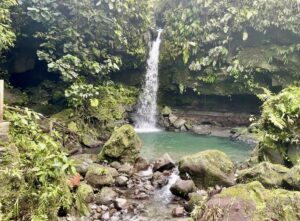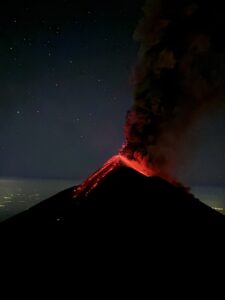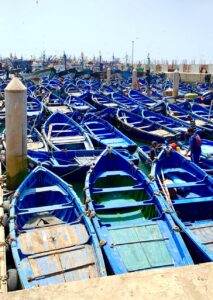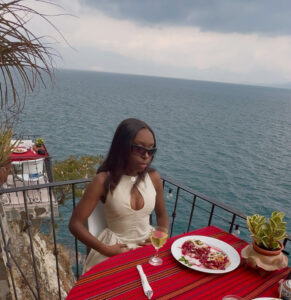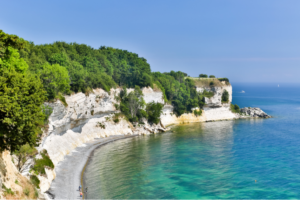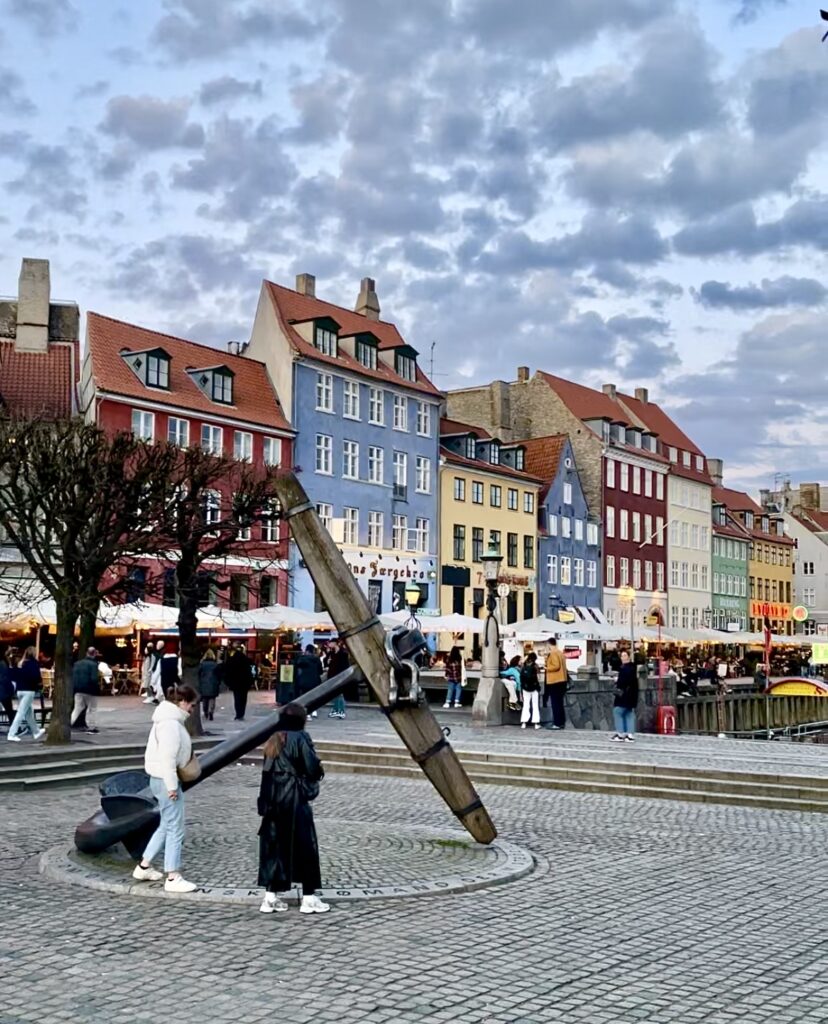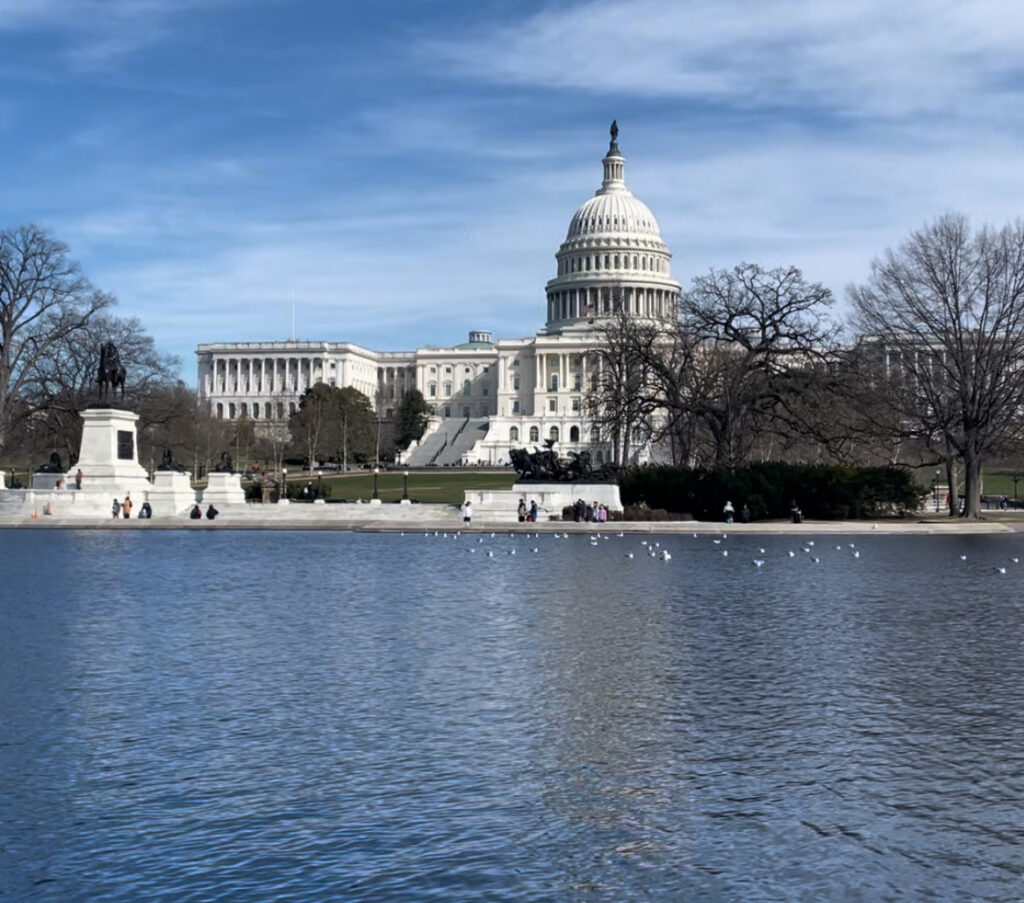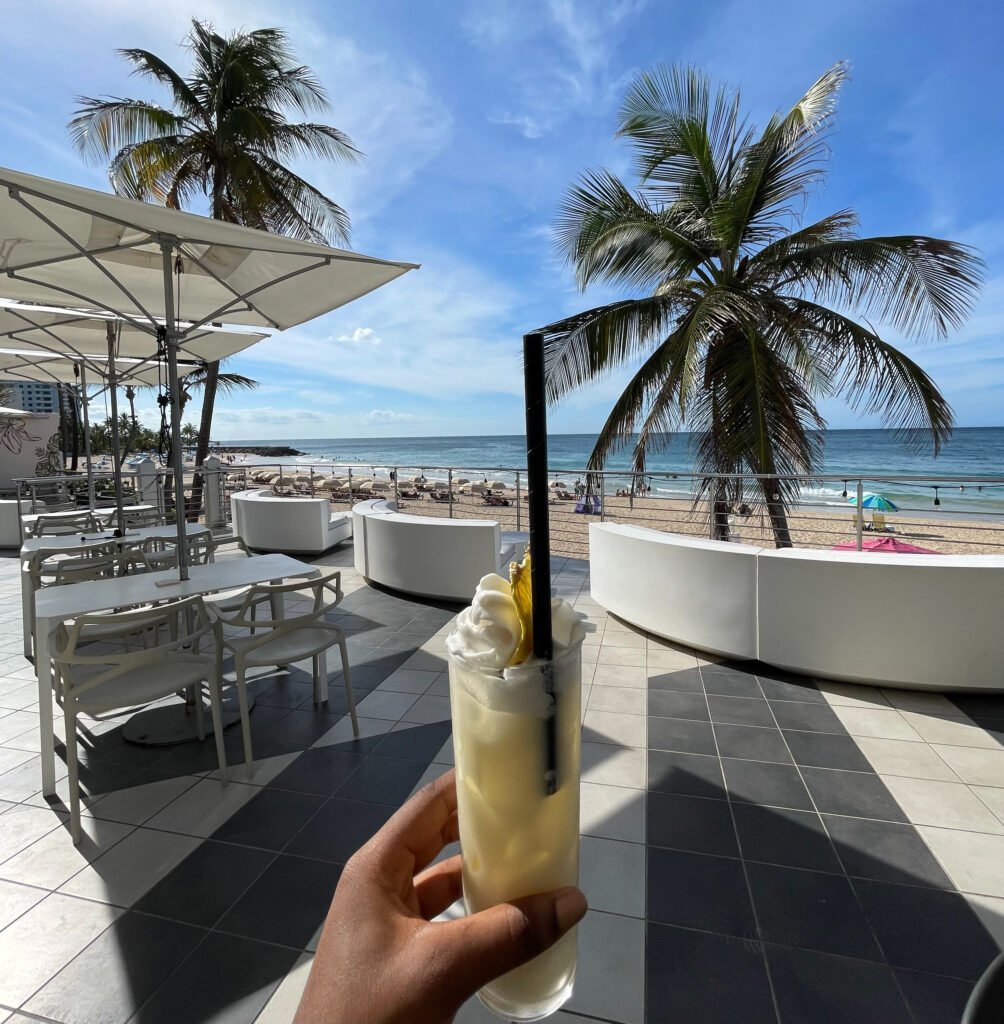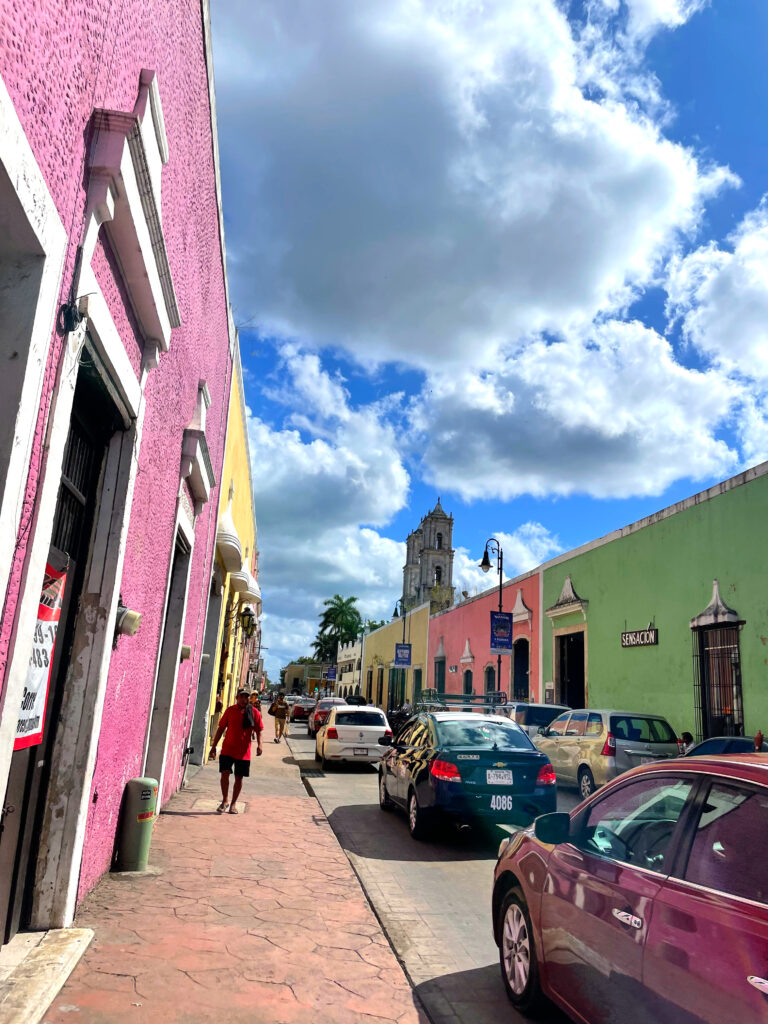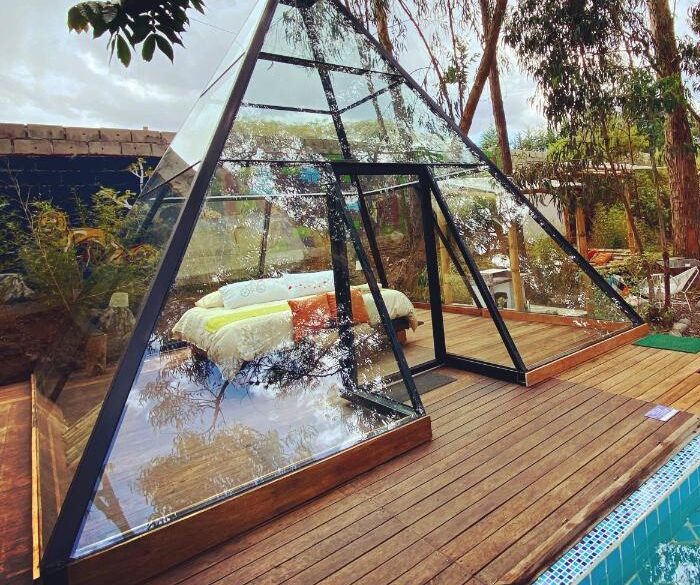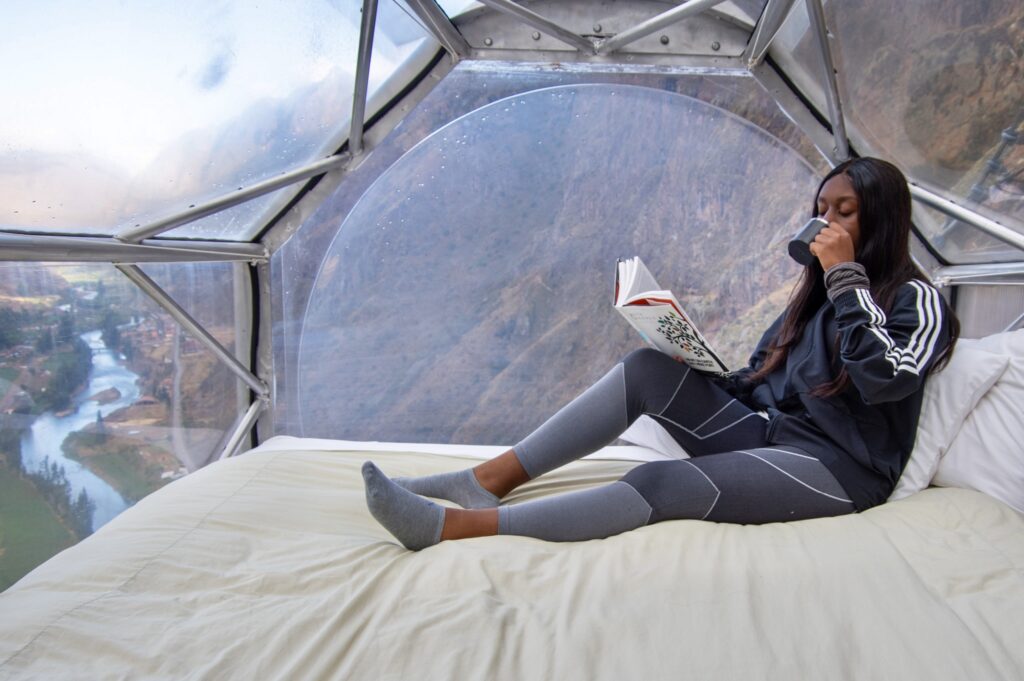Table of Contents
El Salvador surprised me in the best way. I went in with a loose idea of what to expect and ended up hiking a volcano, soaking in hot springs, wandering through mural-covered towns, and swimming in a crater lake. It’s a tiny country that’s packed with variety. You get adventure, nature, history, and good food all in one destination. If you’ve got a weekend to spare, check out my 4-day El Salvador itinerary that covers all of the highlights.Whether you’re into beach days or chasing waterfalls, here are 16 epic things to do in El Salvador to add to your Bucketlist.
1. Hike the Santa Ana Volcano
Did you even go to El Salvador if you did not hike Santa Ana volcano? Santa Ana Volcano, also known as Volcán Ilamatepec, is the tallest volcano in El Salvador and the most popular hikes in the country. The hike takes about 4-5 hours round trip and is moderately challenging. The view of the bright turquoise crater lake at the summit makes it totally worth it. Most people start from the Cerro Verde National Park entrance, where there’s a small park fee of $3 and an optional guide fee of around $6. From the top, you’ll get amazing views of the crater lake and surrounding volcanoes.

2. Visit Lake Coatepeque
Lake Coatepeque is the most beautiful lake in El Salvador and a perfect spot to relax after a your Santa Ana Volcano hike; you can book a tour here that combines both activities in one day. This massive crater lake is surrounded by hills and volcanoes, and the water turns a vibrant turquoise color between August and September. It’s a great place to swim, kayak, or just hang out by the shore with a drink. You’ll find a mix of restaurants and laid-back vacation homes surrounding the lake.
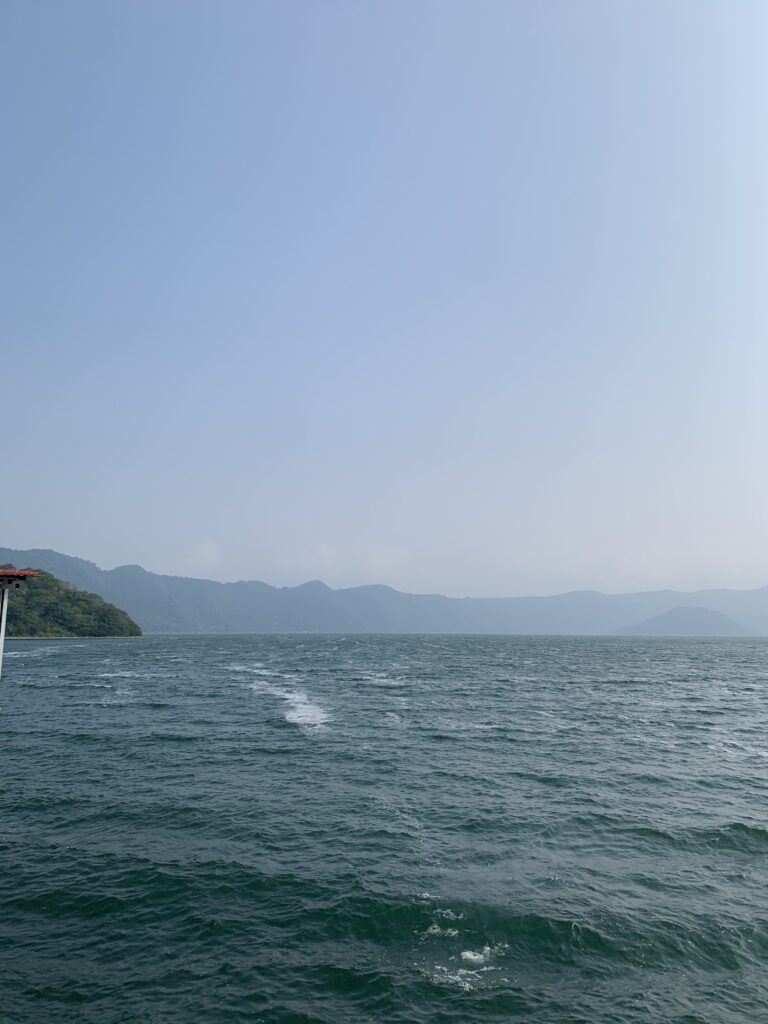
The food around the lake is a little bit more expensive than you’d find at a local restaurant in the city. Most restaurants along the lake will allow you to rent paddle boards, jet skis and have jumping platforms into the lake. If you’re visiting after hiking the Santa Ana Volcano, this is the perfect place to unwind and catch the sunset. I went to La Octoba Maravilla where I had dinner after hiking Santa Ana Volcano and rented jet skis for $20 for 15 minutes. It’s about a 30-minute drive from Cerro Verde National Park and easy to get to by car or a pre-arranged taxi.
3. Explore the Ruta de las Flores
The Ruta de las Flores is one of the most scenic and cultural parts of El Salvador. It’s a stretch of small towns in the mountains, each with its own vibe and something unique to offer. There are 5 towns along the route, and you can book a day tour that will take you through the towns. Nahuizalco is known for its strong indigenous roots and candlelit night market, where you can buy handwoven crafts and woodwork. Salcoatitán is a peaceful town with pretty gardens and old churches, and it’s a nice place to just relax in the plaza.
Juayúa is probably the most popular stop thanks to its weekend food festival where you can try all kinds of Salvadoran dishes like grilled meats, pupusas, yuca and unique take on traditional dishes. There are also nearby waterfalls you can hike to if you’re up for a little adventure. Apaneca is surrounded by coffee fields which makes it a great stop for touring a local coffee farm. Last is Concepción de Ataco, or just Ataco, which feels like a real-life postcard. It’s filled with colorful murals, cobblestone streets, local coffee shops, and artisan markets.
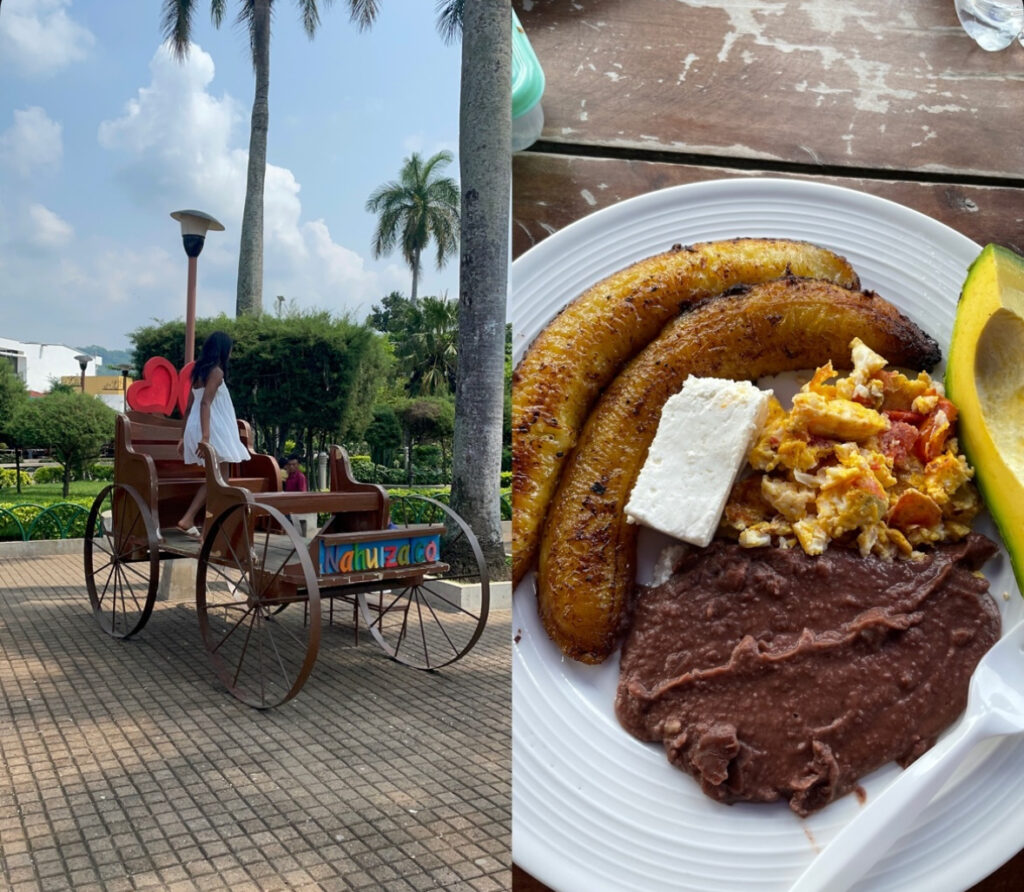
4. Get an Adrenaline Rush at Cafe Albania
Café Albania is a must-stop spot, especially if you’re looking for something fun and a little different. It’s part café, part adventure park, set in the hills near Apaneca and surrounded by coffee fields. The main attractions here are the rainbow slide and the bike zipline that sends you pedaling across the treetops on a cable. There’s also a giant swing, a maze, and regular ziplines if you want to add more adrenaline to your day.
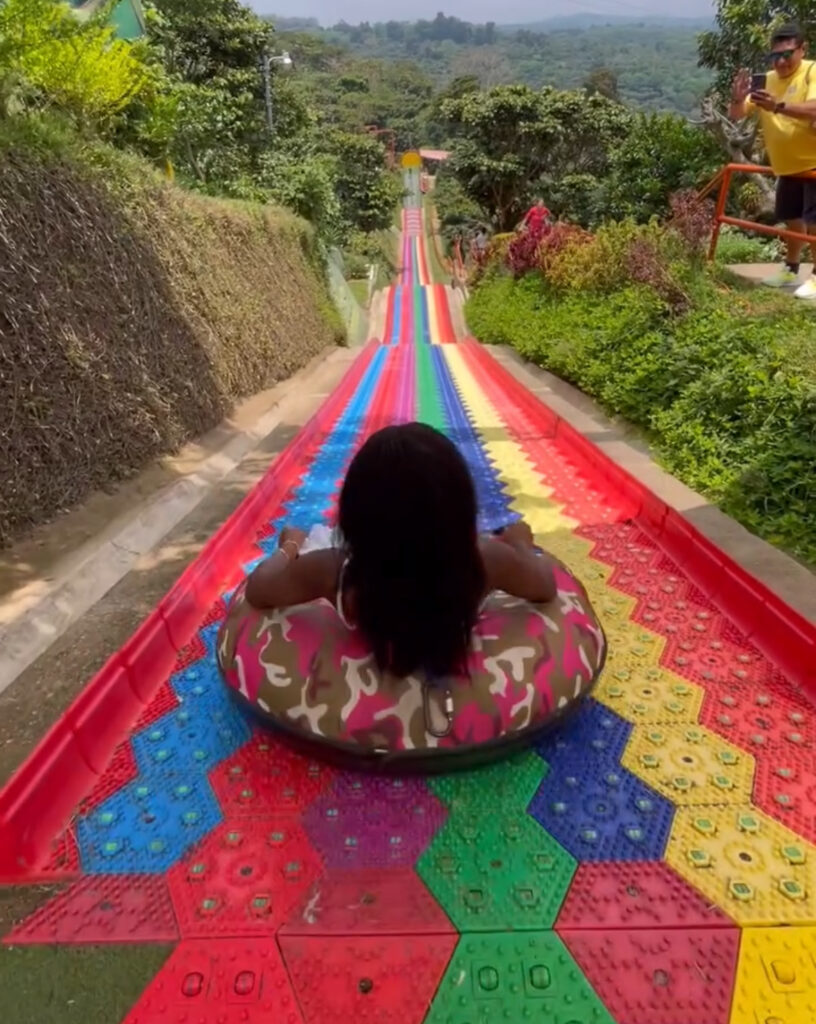
The café itself serves local coffee and snacks, and there are some nice photo spots with views of the mountains. This activity can be easily combined with a town or two along Ruta de Las Flores that interest you the most. You don’t need a reservation, just show up, grab a ticket for whichever activity you want to try, or buy a day pass for $40 and enjoy !
5. Surf and Party in El Tunco
El Tunco also known as “Surf City” is one of El Salvador’s most famous beach towns and it’s a solid place to chill for a day. It has a super laid-back vibe with black sand beaches, palm trees, and that iconic rock formation right off the shore that everyone takes photos of. During the day, you can relax by the water, surf (or take a beginner lesson), or just hang out at one of the oceanfront bars. If you really want to focus on surfing, you can even go to surf camp for anywhere from 2 days to 1 week.
The waves here are strong, so it’s better for surfing than swimming, but there are plenty of spots to lounge with a smoothie or cold beer. The town itself is small and walkable with hostels, food spots, and surf shops packed into a few blocks. When the sun sets, everything slows down for a bit before the nightlife picks up. Most people stick around for live music or DJs at one of the beach bars. If you’re really trying to party in El Salvador, El Tunco is your spot so you may want to spend a few nights in town. It’s super social and a fun place to meet other travelers, even if you’re just in for the day.
6. Surf and Relax in El Zonte

El Zonte is a smaller, more relaxed surf town on El Salvador’s Pacific coast that feels like a peaceful escape. It’s popular with digital nomads, long-term travelers, and anyone looking for good waves without the party scene of El Tunco. The vibe is super chill, with a mix of locals and expats, a few beachfront cafes, yoga spots, and some really cool boutique hotels and hostels.
The waves here are consistent, which makes it a favorite for surfers, but it’s also a great place to unwind even if you’re not surfing. You can walk along the beach, grab tacos or pupusas from small local stands, or catch the sunset from one of the clifftop viewpoints. El Zonte is also known for its tide pools, which show up during low tide and are perfect for a quick dip. It’s quiet, welcoming, and one of those places where you might plan a short visit but end up wishing you stayed longer.
7. Visit San Salvador’s Historic Center
San Salvador’s Historic Center is a great starting point to understand the country’s culture and past. The area is packed with colonial architecture, busy local markets, and major landmarks like the National Palace, Metropolitan Cathedral, and Plaza Barrios. One of the best ways to explore it is by joining a free walking tour, which takes you through the plazas, churches, and even inside local spots like Mercado Ex Cuartel. The free walking tour provided me with a brief but comprehensive overview of San Salvador.
The highlight for a lot of people is Iglesia El Rosario, which looks plain from the outside but has a unique Brutalist Architecture not typical for catholic churches. The colorful stained-glass windows that light up the interior in the coolest way. You can also see bullet hole remnants which highlight the country’s turbulent past. After the tour, head into the National Library, where you can take an elevator to the top floor for a panoramic view of the square as the city lights start to glow.
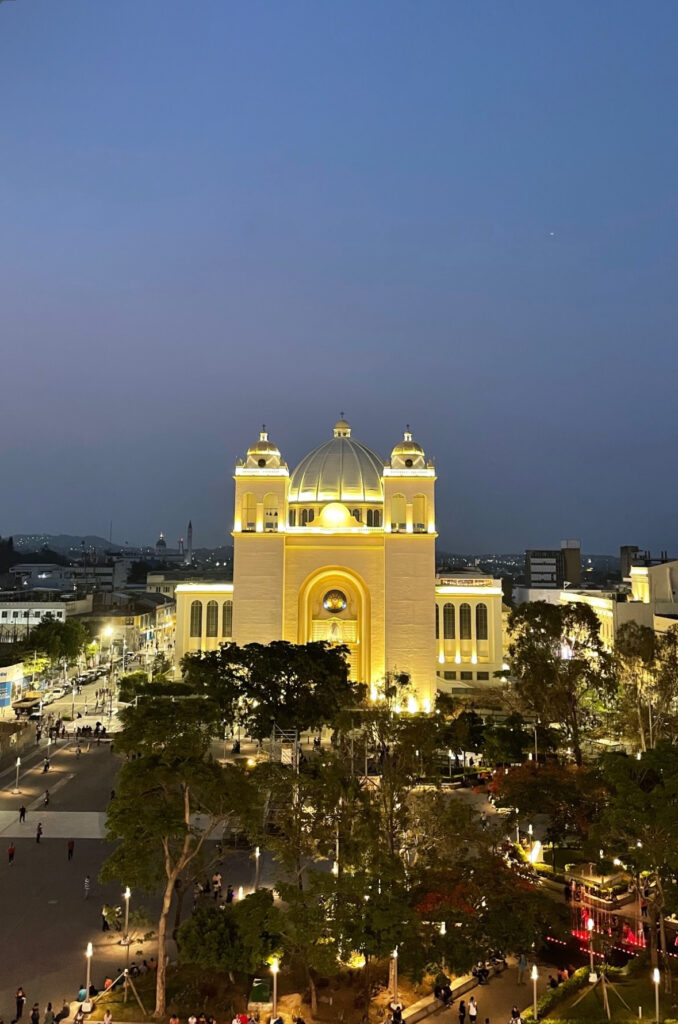
8. Relax at Santa Teresa Hot Springs
Santa Teresa Hot Springs is one of the best places to unwind in El Salvador, especially after a long hike or road trip. I went to this hot spring haven after Cafe Albania. Located near Ahuachapán, this spot has a series of natural hot spring pools that vary in temperature, so you can move around until you find the one that’s just right. Some pools are hotter than others, and there’s even a natural sauna created by volcanic steam.
The setting is peaceful, with tropical greenery and steam rising off the water. I stopped here after going to Cafe Albania and it felt way more authentic than a fancy spa. Entry costs around $10, and you can pay an extra $10 for a mud treatment. It’s a nice change of pace, and a great stop if you’re doing the Ruta de las Flores since it’s nearby. Just don’t forget to bring a towel and flip-flops.
9. Try Pupusas Everywhere
You can’t go to El Salvador and not try pupusas. Pupusas are hands down the most iconic food in El Salvador, and you’ll find them everywhere from street stalls to sit-down restaurants. They’re thick corn tortillas stuffed with a mix of fillings like cheese, beans, chicharrón (pork), or loroco, which is an edible flower popular in Salvadoran cooking.
They’re cooked on a flat grill until the outside is golden and crispy, then served with curtido (a tangy cabbage slaw) and tomato salsa on the side. Eating pupusas is a must-do. Not just because they’re delicious, but because they’re such a big part of daily life here. Most locals eat them for dinner or even breakfast. Pupusas are cheap and cost usually around $0.50 to $1 each. If you’re not sure what to order, try a mix of cheese and bean, or cheese and loroco for a vegetarian-friendly option.
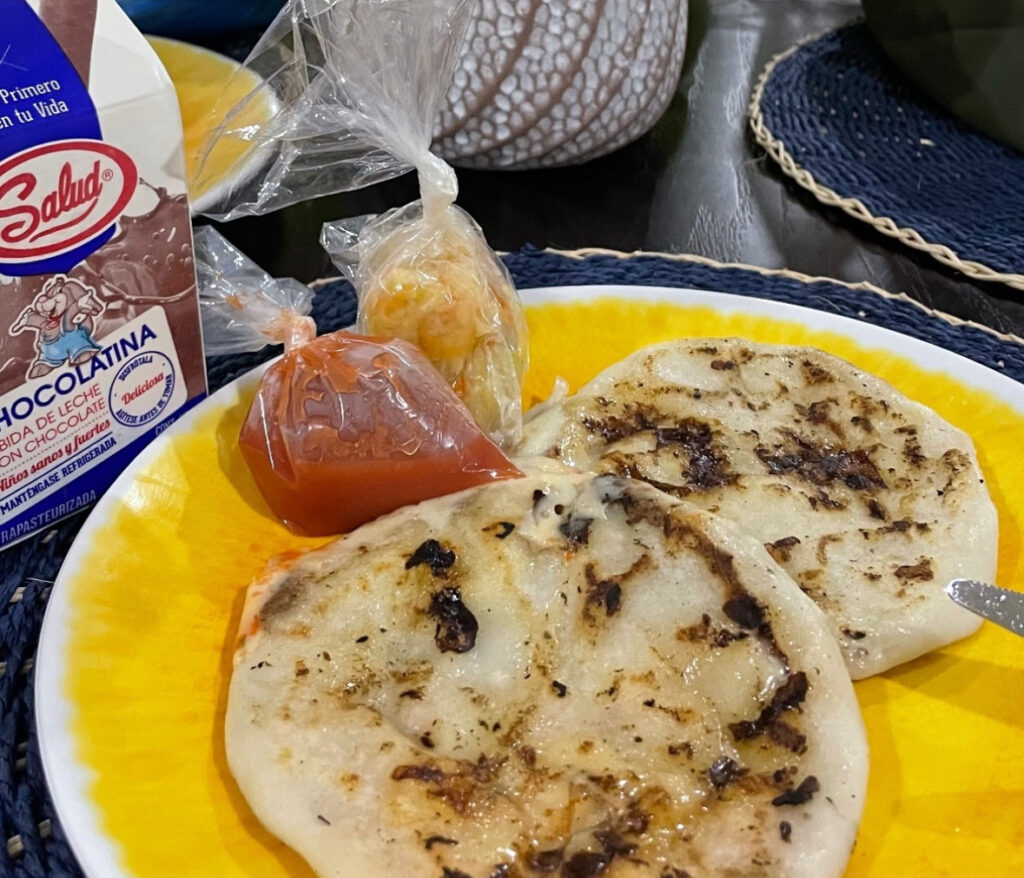
10. Watch the Sunset at Nawi Beach House
Nawi Beach House is a stylish beachfront hotel and restaurant and lounge located on the coast near La Libertad. It’s a popular spot to hang out for a few hours, especially if you’re looking for a relaxing ambiance with good food and drinks by the ocean. What really makes Nawi stand out is its perfect sunset view. If you’re not a guest at the hotel, you can purchase a day pass for $17.5 to 25 USD that includes a welcome drink and free horse ride on the beach.
You can grab a cocktail, find a spot by the pool or beach chairs, and watch the sky change colors as the sun dips into the Pacific. The menu includes seafood, tacos, and smoothies, and while it’s a little more upscale than a roadside pupusería, it’s totally worth it for the atmosphere. It’s also a good stop to squeeze in at the end of your trip, especially if you’re flying out later that night since it’s about 1 hour away from the airport.
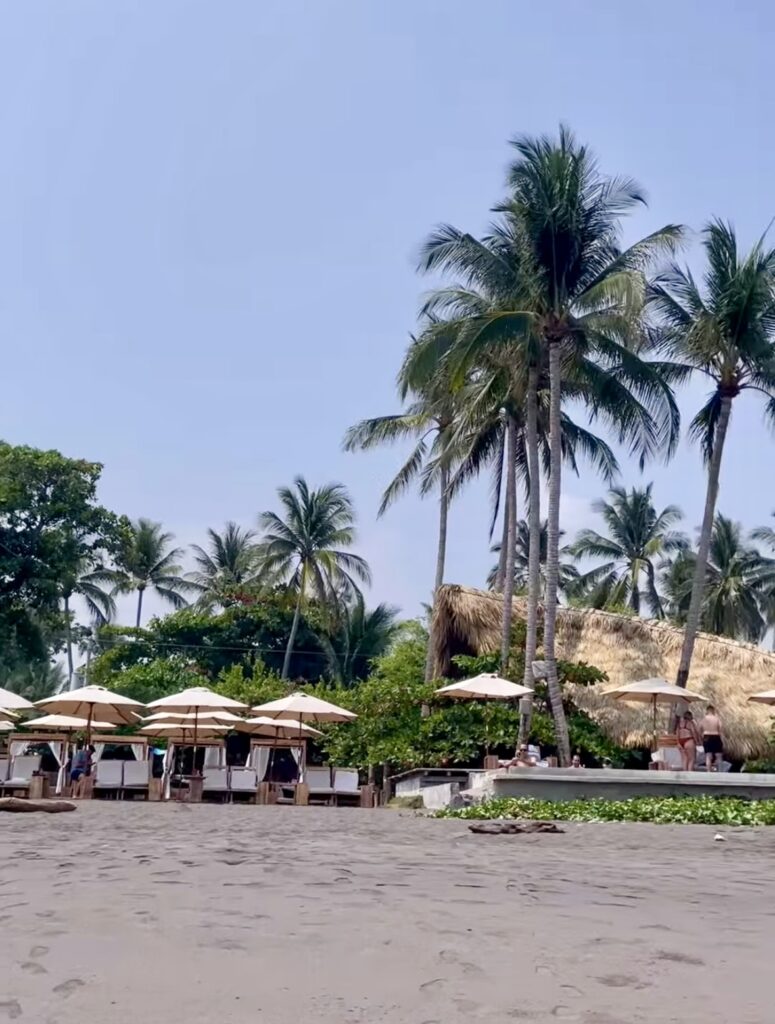
11. Visit Tazumal Ruins
Tazumal is one of the most important pre-Columbian archaeological sites in El Salvador and a solid stop if you’re into history or just want to see something different. It’s located in the town of Chalchuapa, about an hour and a half from San Salvador. Due to the distance from the city, it’s easy to visit as a day trip. The ruins date back to the Maya era and include a main pyramid, tombs, and ancient structures that were once part of a much larger city. It’s not as massive as sites in Mexico or Guatemala, but it still gives you a cool glimpse into El Salvador’s ancient past.
Entry is around $3 for foreigners, and there’s a small museum on site with artifacts and explanations in both Spanish and English. You probably only need an hour or two here, but it’s a great cultural stop to break up your itinerary and explore more of the country’s history. If you’re a history nerd, you will love visiting Tazumal Ruins. It’s easy to add on other historical sites like Joya de Ceren, San Andres and Chalchuhuapa with a guided day tour.
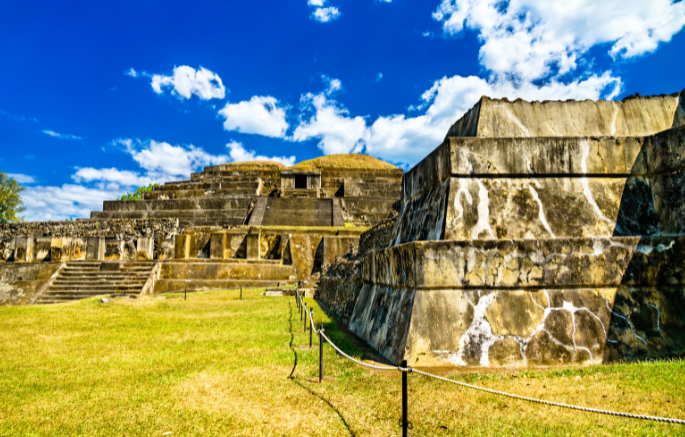
12. Take a Day Trip to Suchitoto
Suchitoto is one of the most charming towns in El Salvador and feels like a step back in time with its cobblestone streets, colorful buildings, and laid-back vibe. It’s located about 45 minutes to an hour from San Salvador, making it an easy and relaxing day trip. The town is known for its colonial architecture, local art galleries, and beautiful views of Lake Suchitlán. It’s a great spot to wander, shop for handmade crafts, and grab lunch at a café with a view. If you’re up for it, you can also take a short boat ride on the lake or visit nearby waterfalls like Cascada Los Cascada Los Tercios is just about a 10–15 minute drive or a 30-minute walk from the center of town.
What makes this waterfall unique is the striking wall of naturally formed hexagonal basalt columns that frame it, they almost look man-made. The waterfall is most impressive during or right after the rainy season (May to October), since it can dry up in the dry season. Even without water, the rock formations are worth seeing. You can also hire a local guide in town if you want a bit of context or help getting there. Suchitoto is quieter than the big cities and beach towns, which makes it a nice break in your trip if you’re looking for something peaceful but still full of culture.
13. Go Chasing Waterfalls
This one is for adventure lovers.The Siete Cascadas hike near Juayúa is one of the most adventurous things you can do in El Salvador. Translating to “Seven Waterfalls,” this guided trek takes you through dense forest, coffee farms, and rocky trails as you chase a series of stunning waterfalls. Some parts of the hike involve climbing, wading through water, and even rappelling down small falls, depending on the tour you choose. It usually takes around 4 to 5 hours to complete and is best done with a local guide. A local guide should cost you around $10 to $15, and it’s a great way to see the more rugged, natural side of the Ruta de Las Flores. Be ready to get wet, muddy, and have a ton of fun along the way.
14. Hike to Los Chorros de la Calera
Los Chorros de la Calera is one of the easiest waterfall hikes you can do around Juayúa but it’s worth it. The trail starts just outside of town and takes about 30 to 45 minutes each way. It’s mostly flat and easy to follow, so you don’t need a guide unless you want one. At the end of the walk, you’ll find a beautiful waterfall flowing out of a rock wall into a clear pool. It’s perfect for a quick swim or just cooling off after the walk. It’s surrounded by trees and pretty quiet especially if you go on a weekday. You don’t have to pay an entrance fee, but tipping any locals helping maintain the trail is a nice gesture.

15. Ride the Ferris Wheel at Cuscatlán Park
Cuscatlán Park is a free laid-back green space in the middle of San Salvador and a nice break from the city noise.It’s not a major tourist spot, but it’s a solid stop if you’re exploring the historic center and want to relax somewhere that locals actually use. It has open lawns, shady trees, walking paths, and local families hanging out, especially on weekends. One of the coolest things here is the small amusement area, where you can ride a Ferris wheel or grab snacks from street vendors. There’s also a giant open-air mural memorial that’s dedicated to the civil war, which adds some historical context to your visit.
16. Visit the National Museum of Anthropology
The National Museum of Anthropology (Museo Nacional de Antropología David J. Guzmán) is good place in El Salvador to learn about the country’s deep history and diverse cultures. It’s located in the San Benito neighborhood of San Salvador, which is safe and easy to get to. The museum covers everything from pre-Columbian civilizations and archaeological finds to colonial history and modern-day traditions. You’ll see artifacts like pottery, tools, and even ancient sculptures, all with descriptions in both Spanish and English. It’s well-organized, not too overwhelming, and gives you a clearer understanding of El Salvador beyond what you see on the streets. Entrance is cheap (usually under $5), and it only takes about an hour or two to go through, so it’s easy to fit into your itinerary.
Conclusion
You could easily spend 2 weeks in El Salvador and still feel like there’s more to see. Between the volcano hikes, colorful towns, beach days, waterfalls, and amazing food, there’s a ton to explore. I genuinely loved this country. It has become one of my favorite countries that I’ve visited. If you’re looking for a shorter trip and want to cover the essentials, check out my detailed 4-day El Salvador itinerary to help you get started. I can’t wait to be back since there’s still so much more to experience.
Disclosure: Explore with Milca is a reader supported website. I may earn a small commission at no additional cost to you when you buy through links on my website.

